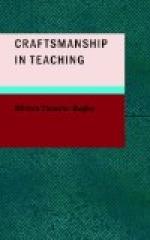well understood when he was in school. But his
education had left with him a general method of procedure
for just such cases, and that method he at once applied.
It had taught him how to find the information that
he needed, provided that such information was available.
It had taught him that human experience is crystallized
in books, and that, when a discovery is made in any
field of science,—no matter how specialized
the field and no matter how trivial the finding,—the
discovery is recorded in printer’s ink and placed
at the disposal of those who have the intelligence
to find it and apply it. And so he set out to
read up on the subject,—to see what other
men had learned about this peculiar kind of apple
rot. He obtained all that had been written about
it and began to master it. He told his friend
about this material and suggested that the latter
follow the same course, but the man of narrow education
soon found himself utterly at sea in a maze of technical
terms. The terms were new to the other too, but
he took down his dictionary and worked them out.
He knew how to use indices and tables of contents and
various other devices that facilitate the gathering
of information, and while his uneducated friend was
storming over the pedantry of men who use big words,
the other was making rapid progress through the material.
In a short time he learned everything that had been
found out about this specific disease. He learned
that its spores are encased in a gelatinous sac which
resisted the entrance of the chemicals. He found
how the spores were reproduced, how they wintered,
how they germinated in the following season; and,
although he did not save much of his crop that year,
he did better the next. Nor were the evidences
of his superiority limited to this very useful result.
He found that, after all, very little was known about
this disease, so he set himself to find out more about
it. To do this, he started where other investigators
had left off, and then he applied a principle he had
learned from his education; namely, that the only
valid methods of obtaining new truths are the methods
of close observation and controlled experiment.
Now I maintain that the education which was given
that man was effective in a degree that ought to make
his experience an object lesson for us who teach.
What he had found most useful at a very critical juncture
of his business life was, primarily, not the technical
knowledge that he had gained either in school or in
actual experience. His superiority lay in the
fact that he knew how to get hold of knowledge when
he needed it, how to master it once he had obtained
it, how to apply it once he had mastered it, and finally
how to go about to discover facts that had been undetected
by previous investigators. I care not whether
he got this knowledge in the elementary school or
in the high school or in the college. He might
have secured it in any one of the three types of institution,
but he had to learn it somewhere, and I shall go further
and say that the average man has to learn it in some
school and under an explicit and conscious method
of instruction.




